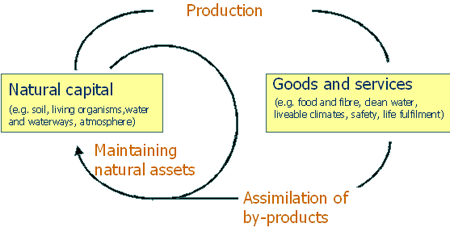Topic 1.1 Ecosystem Services
The Production of Ecosystem Services
As mentioned above ecosystem services are the outcome of the natural processes of ecosystems (e.g., pollination, rain formation, photosynthesis). That is, in the process of living, growing and changing, all the different parts that make up ecosystems provide the essential elements needed to support and sustain human life (e.g., air, water, food, shelter).
For example, soil might be considered to have six categories of ecosystem services.
- Buffering and moderation of the hydrological (i.e. water) cycle
- Physical support of plants
- Nutrient supply to plants
- Disposal of waste and dead organic matter
- Renewal of soil fertility
- Regulation of major elemental cycles (e.g. the nitrogen cycle)
![]()
Activity 1.2
Spend some time now considering Figure 1 and click on each of the diagram labels for further information.
Figure 1. Ecosystem Services are produced by Transformations of Natural Capital

(For definitions used in the above diagram, please Click on Figure 1 Definitions )
Natural capital produces ecological goods and services
Natural capital is the stock of all the elements of ecosystems (e.g a forest system) that produce a flow of goods (e.g trees) and services (e.g carbon storage, erosion control; habitat).
Natural capital provides the raw material for life and for human activities such as manufacturing, agriculture and recreation (refer to Miller & Spoolman, page 9 and Figure 1-4).
The term natural capital is derived from the economics concept that equates the natural capital of ecosystems with the highly valued capital of economic systems. Capital is considered to be a stock of materials or information that exists at a point in time and can be used to generate, by itself, or in conjunction with services from other capital, a flow of services that benefits the well being of humans into the future.
- For example, raw material capital + human capital + $ = manufactured product.
Therefore natural capital can be considered as a stock from which ecosystem services flow and the processes of ecosystems are the procedures or methods used to create the flow of services. Refer to Figure 1 for a diagrammatic representation of how the "flow" of ecosystem services are produced.
In summary, parts of ecosystems have been defined as "natural capital" so that they can be considered and accounted as valuable capital like other forms of capital such as financial capital or human capital.
![]()
Activity 1.3
Q1. Return to the list of ecosystem services you produced to answer Q3 in Activity 1.1 and add to the definition of each service a brief description of how the service is produced (i.e. what parts of the ecosystem for example species, soil, water, atmosphere etc. are involved and what processes are at work). You could use the following table:
| Ecosystem Service |
Description | How the service is produced |
| Natural Pest Control |
Regulation of population size by other organisms (i.e. natural enemies such as predators, parasites and pathogens) or by climatic variables and landscape characteristics that restrict population growth | Organisms feeding on or in otherways increasing the death or reducing the reproduction of a species or by elements of climate or landscape structure increasing the death or reducing the reproduction of a species |
![]()
